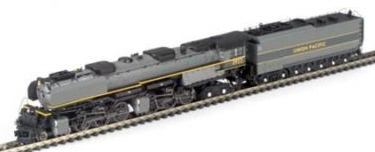Introduced: 1987
This Challenger model was the last of the Con-Cor/Rivarossi steam locomotive releases (actually, the last new Con-Cor/Rivarossi locomotive of any kind). It came out right around the time Rivarossi was replacing the old can motors in their other steam locomotive models with open-sided 3-pole Mabuchi motors. And as such, I don't believe the Challenger ever came with a can motor (I've certainly never seen one that had one, anyway). As far as I know, the only change it ever received over its relatively brief lifespan was the addition of blackened wheels (in the mid-to-late 1990s). Due to the bankruptcy and subsequent liquidation of the Rivarossi Company in February of 2006, this model has been discontinued.
These were available with or without smoke deflectors. Additionally, there were several different tender options - Long Distance Coal (above), Centipede and Vanderbilt-


All of the tenders were recycled from other (earlier) models - Long Distance Coal from the 4-6-2 Heavy Pacific, Vanderbilt from the 2-8-2 Heavy Mikado, and Centipede from the 4-8-8-4 Big Boy.

The chassis is all-metal and quite hefty. As mentioned previously, the motor is an open-sided Mabuchi (3-pole / skew-wound). The right-forward drivers pick up right rail current, while the pilot truck and left-rear drivers pick up left rail current. All the rest of the wheels are electrically neutral (including the tender). Traction tires are installed on two of the left-forward drivers and two of the right-rear drivers. All the drivers are geared and all the gearing is metal. A non-directional headlight is mounted to the pilot assembly. The tender has a body-mounted Rapido-style coupler. There is no provision for a coupler on the pilot. The plastic tender drawbar clips into a socket on the back of the locomotive. The wheel flanges are oversized, so Code-55 track is out of the question.
Performance is pretty solid, but not really up to the standards of the other Rivarossi articulateds (Mallet and Big Boy). The mechanism is capable of smooth running, but the somewhat limited pickup scheme (basically equivalent to that of an 0-6-0 steamer) does lead to occasional balkiness (particularly through turnouts). These are capable of running at very slow speeds (as long as your track is spotless and you don't try creeping them through a turnout). On the other hand, the top-end speed is exceedingly high. And although they run relatively quietly, the motor emits this eerie (nigh indescribable) "wheezing moan". Frankly, it's a bit weird and distracting. These models are capable of navigating narrow radius (9.75") curves, but performance tends to be pretty choppy whilst doing so. On the plus side, they don't seem to have any problems with derailing. Pulling power is strong.
So, not a horrible locomotive. But, one that certainly would have benefited from some additional pickup (either from the tender or from some of those unused drivers). As is, these models are pretty much useless on layouts with narrow radius curves and/or turnouts with unpowered frogs. Also, one noteworthy problem with at least some of these (along with Rivarossi's other N scale steamers) relates to the thick white gear grease Rivarossi used during at least part of their production run. Over time, this "stuff" (whatever it is/was) will degrade to the consistency of hardened peanut butter (basically causing the entire mechanism to seize up). Sadly, the only real solution to the problem is to completely disassemble the model and give all of the gears a thorough cleansing with alcohol. And hey, good luck with all that.
Trivia - Richmond Controls makes an electrical contact improvement kit for these models (designed to be installed in the tender). I don't have any experience with them myself, but one would assume that adding tender wheel pickup to these models could only serve to make them run better. However, note that the tenders on these models are not particularly friendly when it comes to getting inside. The top, bottom, and sides are all a single casting and the ends are firmly glued in place. Consequently, opening one up without damaging it is virtually impossible.
More trivia - Con-Cor's Challenger can be converted into a Northern Pacific Z-8 (using GHQ's pewter shell kit) -

To remove the locomotive shell, first unscrew the screw inside the smokestack. Once that's out, slide the shell backwards to free the clip that locks the cab end to the chassis. The shell should lift right off at that point.
Grade: C